PONTIAC VIBE 2010 Owners Manual
Manufacturer: PONTIAC, Model Year: 2010, Model line: VIBE, Model: PONTIAC VIBE 2010Pages: 318, PDF Size: 1.7 MB
Page 261 of 318
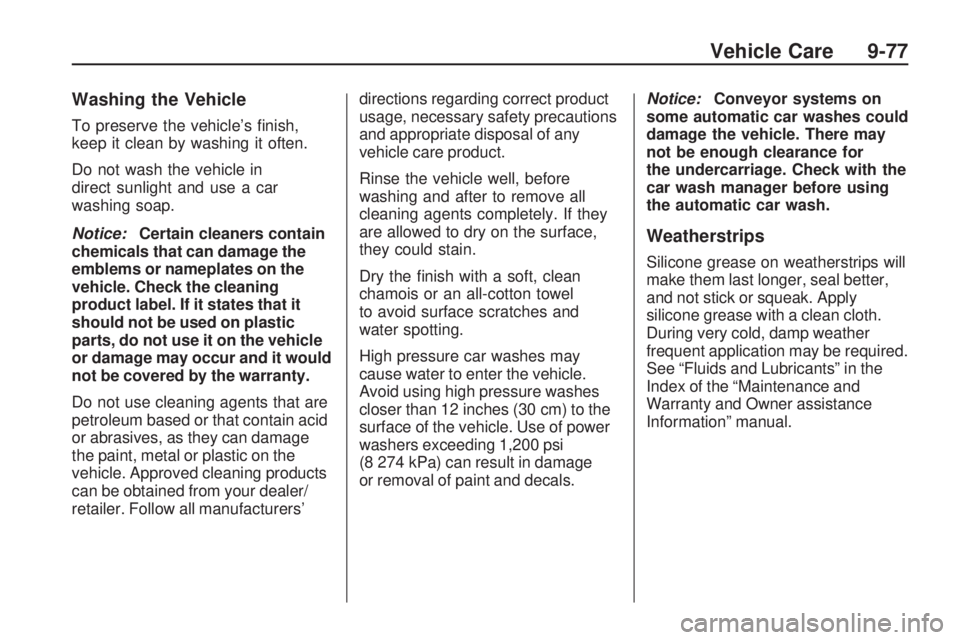
Washing the Vehicle
To preserve the vehicle’s finish,
keep it clean by washing it often.
Do not wash the vehicle in
direct sunlight and use a car
washing soap.
Notice:Certain cleaners contain
chemicals that can damage the
emblems or nameplates on the
vehicle. Check the cleaning
product label. If it states that it
should not be used on plastic
parts, do not use it on the vehicle
or damage may occur and it would
not be covered by the warranty.
Do not use cleaning agents that are
petroleum based or that contain acid
or abrasives, as they can damage
the paint, metal or plastic on the
vehicle. Approved cleaning products
can be obtained from your dealer/
retailer. Follow all manufacturers’ directions regarding correct product
usage, necessary safety precautions
and appropriate disposal of any
vehicle care product.
Rinse the vehicle well, before
washing and after to remove all
cleaning agents completely. If they
are allowed to dry on the surface,
they could stain.
Dry the finish with a soft, clean
chamois or an all-cotton towel
to avoid surface scratches and
water spotting.
High pressure car washes may
cause water to enter the vehicle.
Avoid using high pressure washes
closer than 12 inches (30 cm) to the
surface of the vehicle. Use of power
washers exceeding 1,200 psi
(8 274 kPa) can result in damage
or removal of paint and decals.
Notice:
Conveyor systems on
some automatic car washes could
damage the vehicle. There may
not be enough clearance for
the undercarriage. Check with the
car wash manager before using
the automatic car wash.
Weatherstrips
Silicone grease on weatherstrips will
make them last longer, seal better,
and not stick or squeak. Apply
silicone grease with a clean cloth.
During very cold, damp weather
frequent application may be required.
See “Fluids and Lubricants” in the
Index of the “Maintenance and
Warranty and Owner assistance
Information” manual.
Vehicle Care 9-77
Page 262 of 318
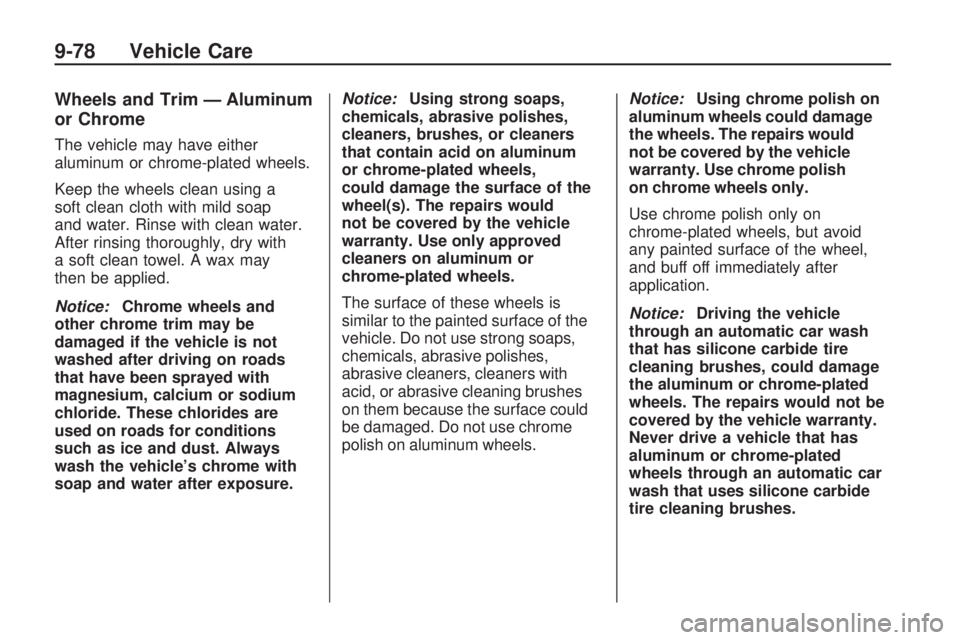
Wheels and Trim — Aluminum
or Chrome
The vehicle may have either
aluminum or chrome-plated wheels.
Keep the wheels clean using a
soft clean cloth with mild soap
and water. Rinse with clean water.
After rinsing thoroughly, dry with
a soft clean towel. A wax may
then be applied.
Notice:Chrome wheels and
other chrome trim may be
damaged if the vehicle is not
washed after driving on roads
that have been sprayed with
magnesium, calcium or sodium
chloride. These chlorides are
used on roads for conditions
such as ice and dust. Always
wash the vehicle’s chrome with
soap and water after exposure. Notice:
Using strong soaps,
chemicals, abrasive polishes,
cleaners, brushes, or cleaners
that contain acid on aluminum
or chrome-plated wheels,
could damage the surface of the
wheel(s). The repairs would
not be covered by the vehicle
warranty. Use only approved
cleaners on aluminum or
chrome-plated wheels.
The surface of these wheels is
similar to the painted surface of the
vehicle. Do not use strong soaps,
chemicals, abrasive polishes,
abrasive cleaners, cleaners with
acid, or abrasive cleaning brushes
on them because the surface could
be damaged. Do not use chrome
polish on aluminum wheels. Notice:
Using chrome polish on
aluminum wheels could damage
the wheels. The repairs would
not be covered by the vehicle
warranty. Use chrome polish
on chrome wheels only.
Use chrome polish only on
chrome-plated wheels, but avoid
any painted surface of the wheel,
and buff off immediately after
application.
Notice: Driving the vehicle
through an automatic car wash
that has silicone carbide tire
cleaning brushes, could damage
the aluminum or chrome-plated
wheels. The repairs would not be
covered by the vehicle warranty.
Never drive a vehicle that has
aluminum or chrome-plated
wheels through an automatic car
wash that uses silicone carbide
tire cleaning brushes.
9-78 Vehicle Care
Page 263 of 318
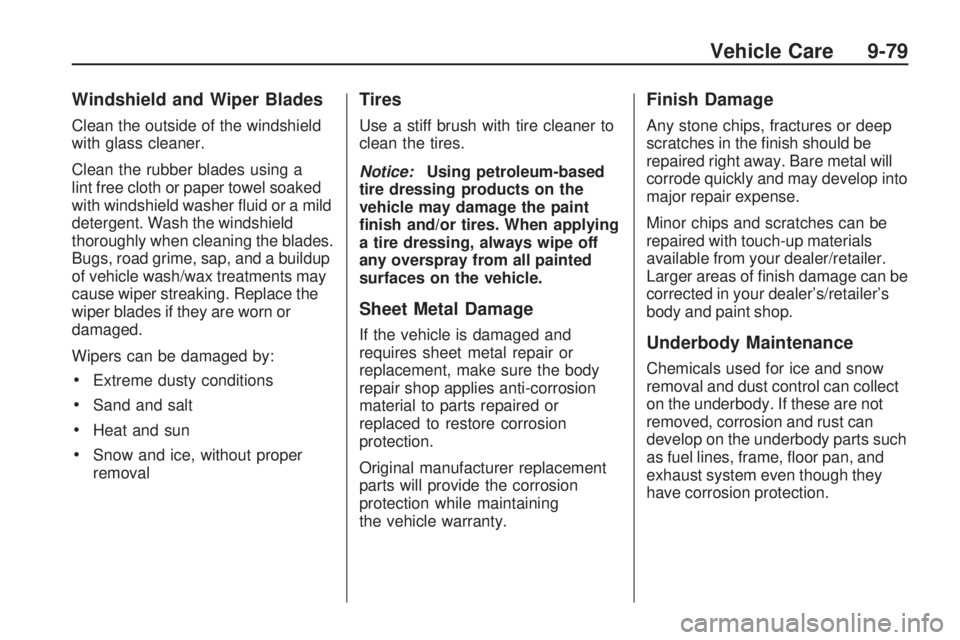
Windshield and Wiper Blades
Clean the outside of the windshield
with glass cleaner.
Clean the rubber blades using a
lint free cloth or paper towel soaked
with windshield washer fluid or a mild
detergent. Wash the windshield
thoroughly when cleaning the blades.
Bugs, road grime, sap, and a buildup
of vehicle wash/wax treatments may
cause wiper streaking. Replace the
wiper blades if they are worn or
damaged.
Wipers can be damaged by:
•Extreme dusty conditions
•Sand and salt
•Heat and sun
•Snow and ice, without proper
removal
Tires
Use a stiff brush with tire cleaner to
clean the tires.
Notice:Using petroleum-based
tire dressing products on the
vehicle may damage the paint
�nish and/or tires. When applying
a tire dressing, always wipe off
any overspray from all painted
surfaces on the vehicle.
Sheet Metal Damage
If the vehicle is damaged and
requires sheet metal repair or
replacement, make sure the body
repair shop applies anti-corrosion
material to parts repaired or
replaced to restore corrosion
protection.
Original manufacturer replacement
parts will provide the corrosion
protection while maintaining
the vehicle warranty.
Finish Damage
Any stone chips, fractures or deep
scratches in the finish should be
repaired right away. Bare metal will
corrode quickly and may develop into
major repair expense.
Minor chips and scratches can be
repaired with touch-up materials
available from your dealer/retailer.
Larger areas of finish damage can be
corrected in your dealer’s/retailer’s
body and paint shop.
Underbody Maintenance
Chemicals used for ice and snow
removal and dust control can collect
on the underbody. If these are not
removed, corrosion and rust can
develop on the underbody parts such
as fuel lines, frame, floor pan, and
exhaust system even though they
have corrosion protection.
Vehicle Care 9-79
Page 264 of 318
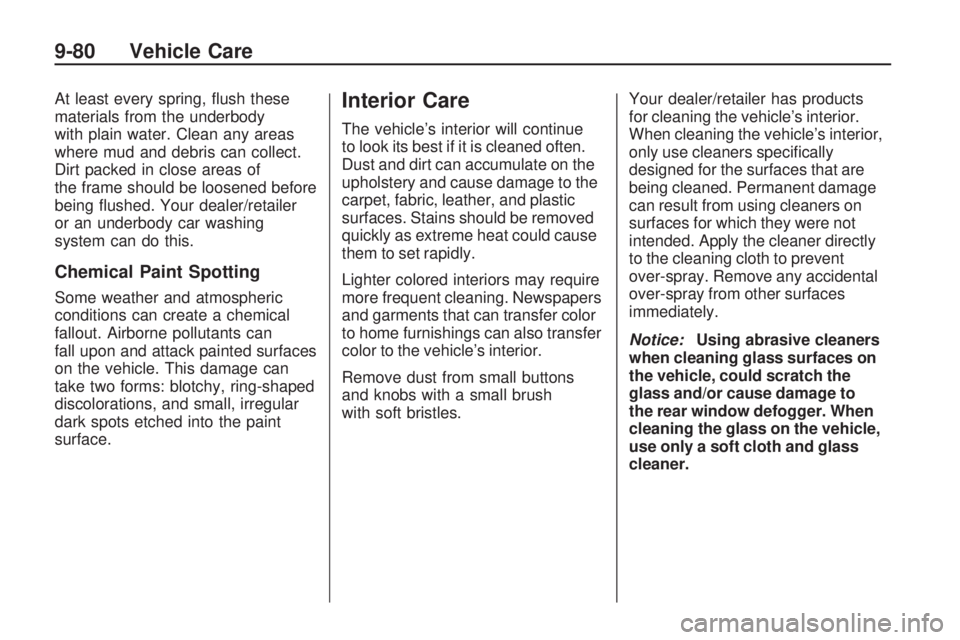
At least every spring, flush these
materials from the underbody
with plain water. Clean any areas
where mud and debris can collect.
Dirt packed in close areas of
the frame should be loosened before
being flushed. Your dealer/retailer
or an underbody car washing
system can do this.
Chemical Paint Spotting
Some weather and atmospheric
conditions can create a chemical
fallout. Airborne pollutants can
fall upon and attack painted surfaces
on the vehicle. This damage can
take two forms: blotchy, ring-shaped
discolorations, and small, irregular
dark spots etched into the paint
surface.
Interior Care
The vehicle’s interior will continue
to look its best if it is cleaned often.
Dust and dirt can accumulate on the
upholstery and cause damage to the
carpet, fabric, leather, and plastic
surfaces. Stains should be removed
quickly as extreme heat could cause
them to set rapidly.
Lighter colored interiors may require
more frequent cleaning. Newspapers
and garments that can transfer color
to home furnishings can also transfer
color to the vehicle’s interior.
Remove dust from small buttons
and knobs with a small brush
with soft bristles.Your dealer/retailer has products
for cleaning the vehicle’s interior.
When cleaning the vehicle’s interior,
only use cleaners specifically
designed for the surfaces that are
being cleaned. Permanent damage
can result from using cleaners on
surfaces for which they were not
intended. Apply the cleaner directly
to the cleaning cloth to prevent
over-spray. Remove any accidental
over-spray from other surfaces
immediately.
Notice:
Using abrasive cleaners
when cleaning glass surfaces on
the vehicle, could scratch the
glass and/or cause damage to
the rear window defogger. When
cleaning the glass on the vehicle,
use only a soft cloth and glass
cleaner.
9-80 Vehicle Care
Page 265 of 318
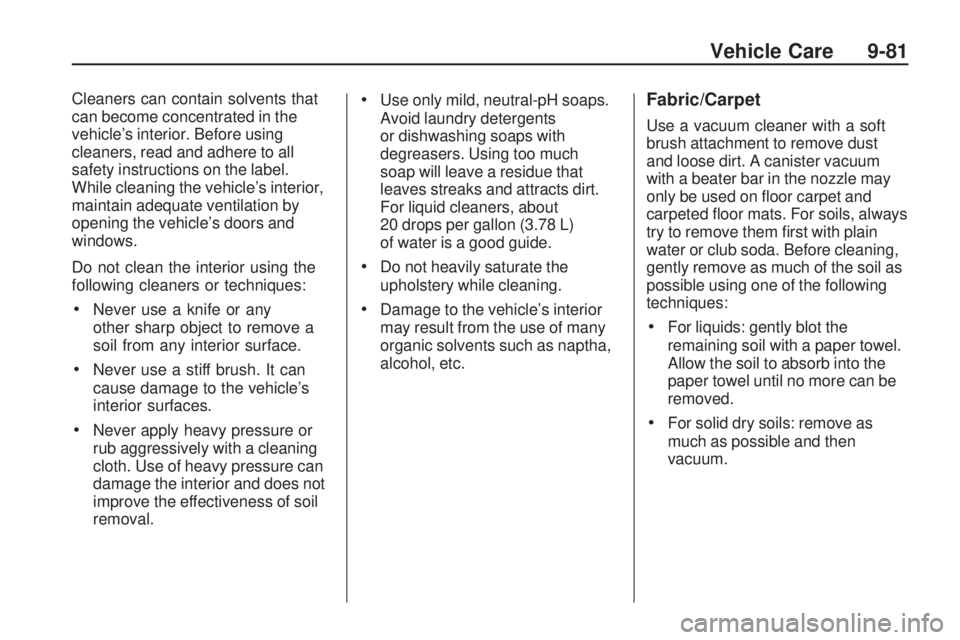
Cleaners can contain solvents that
can become concentrated in the
vehicle’s interior. Before using
cleaners, read and adhere to all
safety instructions on the label.
While cleaning the vehicle’s interior,
maintain adequate ventilation by
opening the vehicle’s doors and
windows.
Do not clean the interior using the
following cleaners or techniques:
•Never use a knife or any
other sharp object to remove a
soil from any interior surface.
•Never use a stiff brush. It can
cause damage to the vehicle’s
interior surfaces.
•Never apply heavy pressure or
rub aggressively with a cleaning
cloth. Use of heavy pressure can
damage the interior and does not
improve the effectiveness of soil
removal.
•Use only mild, neutral-pH soaps.
Avoid laundry detergents
or dishwashing soaps with
degreasers. Using too much
soap will leave a residue that
leaves streaks and attracts dirt.
For liquid cleaners, about
20 drops per gallon (3.78 L)
of water is a good guide.
•Do not heavily saturate the
upholstery while cleaning.
•Damage to the vehicle’s interior
may result from the use of many
organic solvents such as naptha,
alcohol, etc.
Fabric/Carpet
Use a vacuum cleaner with a soft
brush attachment to remove dust
and loose dirt. A canister vacuum
with a beater bar in the nozzle may
only be used on floor carpet and
carpeted floor mats. For soils, always
try to remove them first with plain
water or club soda. Before cleaning,
gently remove as much of the soil as
possible using one of the following
techniques:
•For liquids: gently blot the
remaining soil with a paper towel.
Allow the soil to absorb into the
paper towel until no more can be
removed.
•For solid dry soils: remove as
much as possible and then
vacuum.
Vehicle Care 9-81
Page 266 of 318
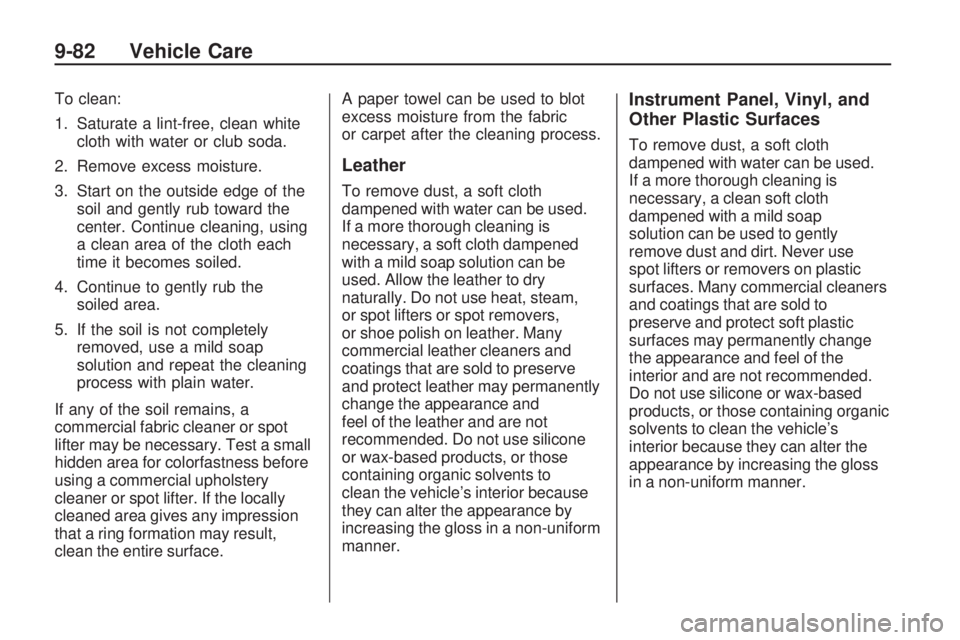
To clean:
1. Saturate a lint-free, clean whitecloth with water or club soda.
2. Remove excess moisture.
3. Start on the outside edge of the soil and gently rub toward the
center. Continue cleaning, using
a clean area of the cloth each
time it becomes soiled.
4. Continue to gently rub the soiled area.
5. If the soil is not completely removed, use a mild soap
solution and repeat the cleaning
process with plain water.
If any of the soil remains, a
commercial fabric cleaner or spot
lifter may be necessary. Test a small
hidden area for colorfastness before
using a commercial upholstery
cleaner or spot lifter. If the locally
cleaned area gives any impression
that a ring formation may result,
clean the entire surface. A paper towel can be used to blot
excess moisture from the fabric
or carpet after the cleaning process.
Leather
To remove dust, a soft cloth
dampened with water can be used.
If a more thorough cleaning is
necessary, a soft cloth dampened
with a mild soap solution can be
used. Allow the leather to dry
naturally. Do not use heat, steam,
or spot lifters or spot removers,
or shoe polish on leather. Many
commercial leather cleaners and
coatings that are sold to preserve
and protect leather may permanently
change the appearance and
feel of the leather and are not
recommended. Do not use silicone
or wax-based products, or those
containing organic solvents to
clean the vehicle’s interior because
they can alter the appearance by
increasing the gloss in a non-uniform
manner.
Instrument Panel, Vinyl, and
Other Plastic Surfaces
To remove dust, a soft cloth
dampened with water can be used.
If a more thorough cleaning is
necessary, a clean soft cloth
dampened with a mild soap
solution can be used to gently
remove dust and dirt. Never use
spot lifters or removers on plastic
surfaces. Many commercial cleaners
and coatings that are sold to
preserve and protect soft plastic
surfaces may permanently change
the appearance and feel of the
interior and are not recommended.
Do not use silicone or wax-based
products, or those containing organic
solvents to clean the vehicle’s
interior because they can alter the
appearance by increasing the gloss
in a non-uniform manner.
9-82 Vehicle Care
Page 267 of 318
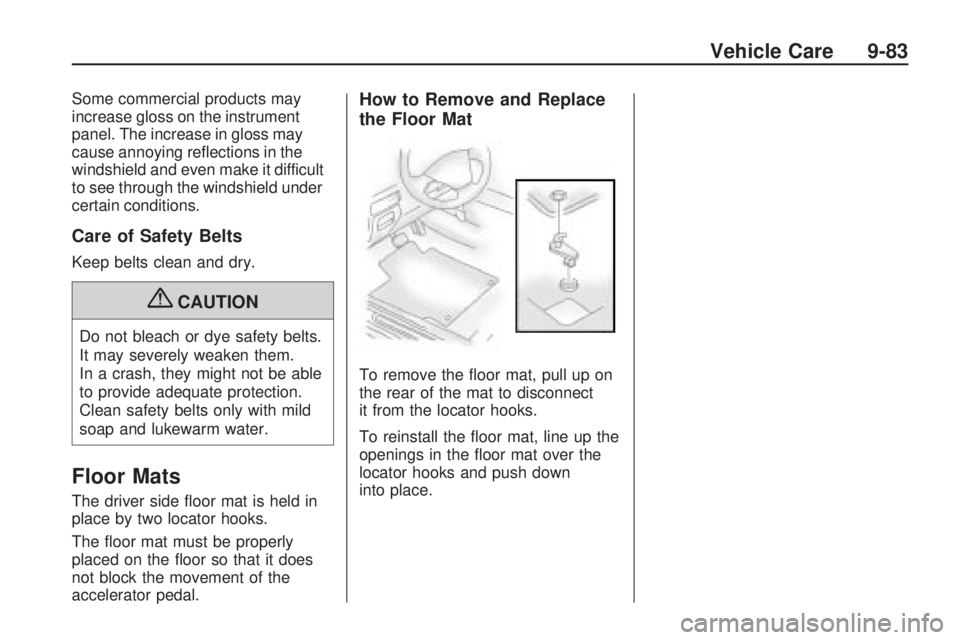
Some commercial products may
increase gloss on the instrument
panel. The increase in gloss may
cause annoying reflections in the
windshield and even make it difficult
to see through the windshield under
certain conditions.
Care of Safety Belts
Keep belts clean and dry.
{CAUTION
Do not bleach or dye safety belts.
It may severely weaken them.
In a crash, they might not be able
to provide adequate protection.
Clean safety belts only with mild
soap and lukewarm water.
Floor Mats
The driver side floor mat is held in
place by two locator hooks.
The floor mat must be properly
placed on the floor so that it does
not block the movement of the
accelerator pedal.
How to Remove and Replace
the Floor Mat
To remove the floor mat, pull up on
the rear of the mat to disconnect
it from the locator hooks.
To reinstall the floor mat, line up the
openings in the floor mat over the
locator hooks and push down
into place.
Vehicle Care 9-83
Page 268 of 318
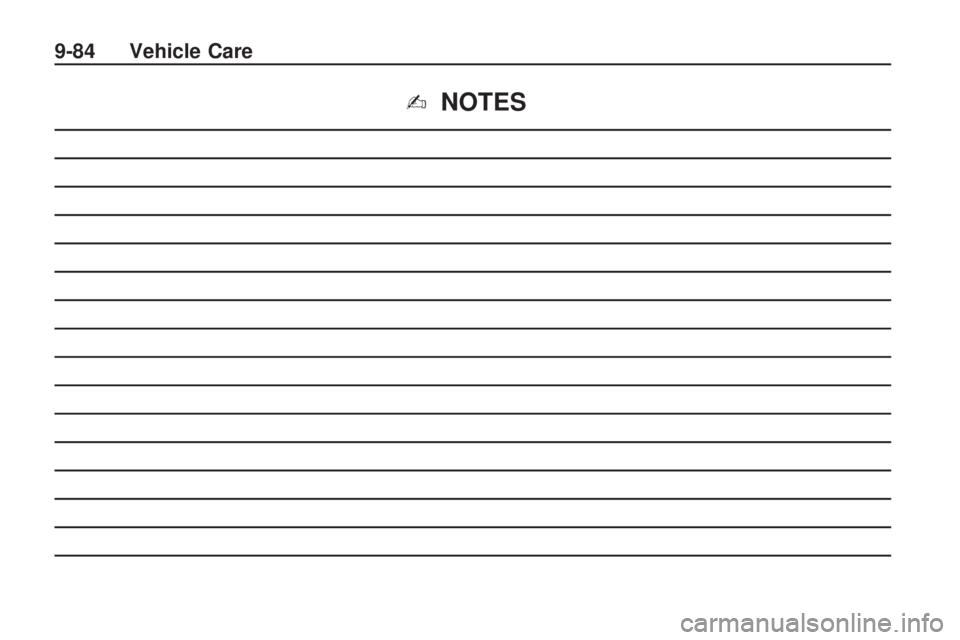
✍NOTES
9-84 Vehicle Care
Page 269 of 318
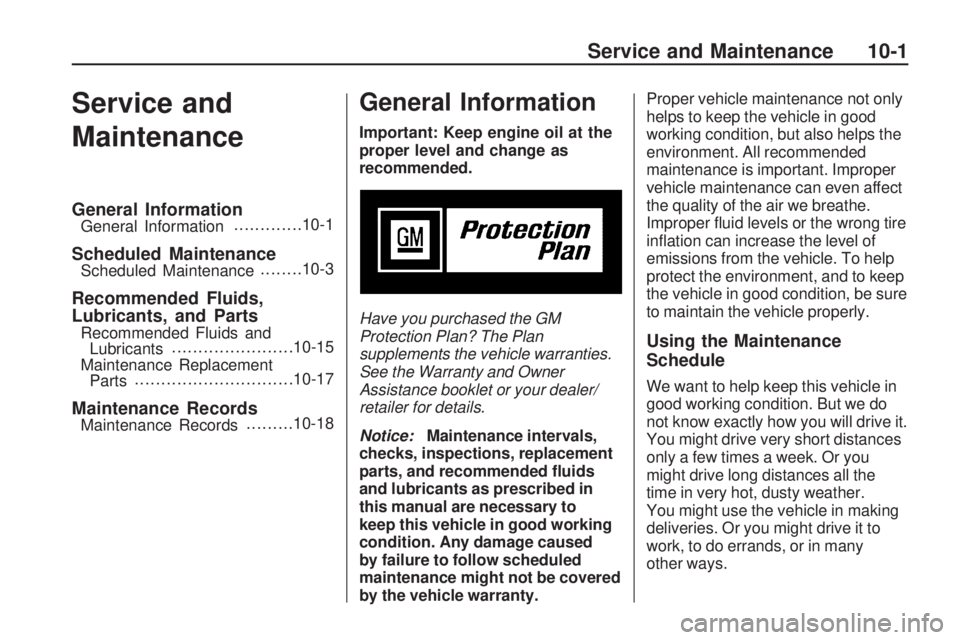
Service and
Maintenance
General InformationGeneral Information.............10-1
Scheduled MaintenanceScheduled Maintenance ........10-3
Recommended Fluids,
Lubricants, and Parts
Recommended Fluids and
Lubricants ......................
.10-15
Maintenance Replacement Parts .............................
.10-17
Maintenance RecordsMaintenance Records .........10-18
General Information
Important: Keep engine oil at the
proper level and change as
recommended.
Have you purchased the GM
Protection Plan? The Plan
supplements the vehicle warranties.
See the Warranty and Owner
Assistance booklet or your dealer/
retailer for details.
Notice:
Maintenance intervals,
checks, inspections, replacement
parts, and recommended �uids
and lubricants as prescribed in
this manual are necessary to
keep this vehicle in good working
condition. Any damage caused
by failure to follow scheduled
maintenance might not be covered
by the vehicle warranty. Proper vehicle maintenance not only
helps to keep the vehicle in good
working condition, but also helps the
environment. All recommended
maintenance is important. Improper
vehicle maintenance can even affect
the quality of the air we breathe.
Improper fluid levels or the wrong tire
inflation can increase the level of
emissions from the vehicle. To help
protect the environment, and to keep
the vehicle in good condition, be sure
to maintain the vehicle properly.
Using the Maintenance
Schedule
We want to help keep this vehicle in
good working condition. But we do
not know exactly how you will drive it.
You might drive very short distances
only a few times a week. Or you
might drive long distances all the
time in very hot, dusty weather.
You might use the vehicle in making
deliveries. Or you might drive it to
work, to do errands, or in many
other ways.
Service and Maintenance 10-1
Page 270 of 318
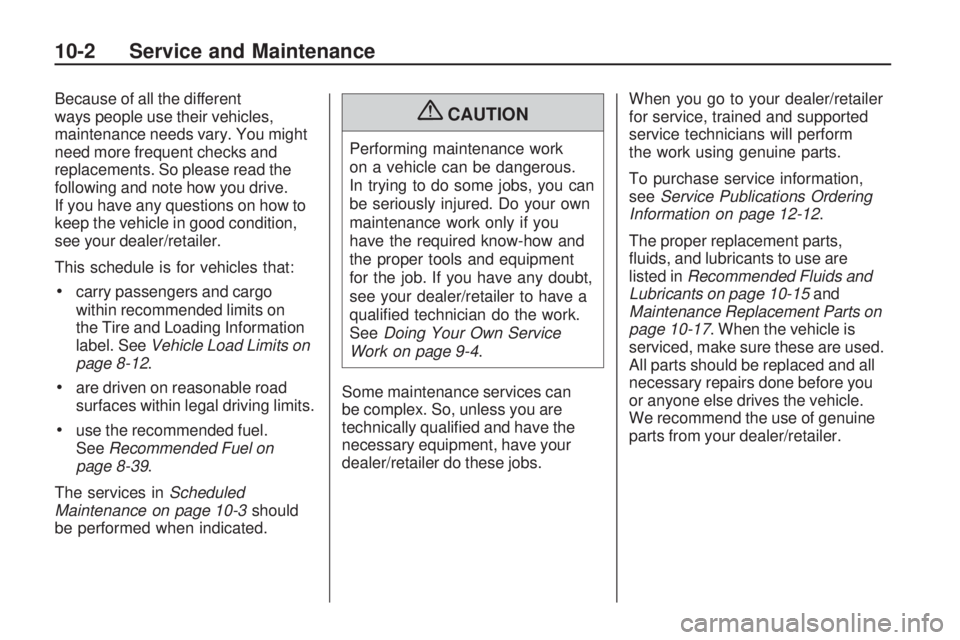
Because of all the different
ways people use their vehicles,
maintenance needs vary. You might
need more frequent checks and
replacements. So please read the
following and note how you drive.
If you have any questions on how to
keep the vehicle in good condition,
see your dealer/retailer.
This schedule is for vehicles that:
•carry passengers and cargo
within recommended limits on
the Tire and Loading Information
label. SeeVehicle Load Limits on
page 8-12.
•are driven on reasonable road
surfaces within legal driving limits.
•use the recommended fuel.
See Recommended Fuel on
page 8-39.
The services in Scheduled
Maintenance on page 10-3 should
be performed when indicated.
{CAUTION
Performing maintenance work
on a vehicle can be dangerous.
In trying to do some jobs, you can
be seriously injured. Do your own
maintenance work only if you
have the required know-how and
the proper tools and equipment
for the job. If you have any doubt,
see your dealer/retailer to have a
qualified technician do the work.
See Doing Your Own Service
Work on page 9-4.
Some maintenance services can
be complex. So, unless you are
technically qualified and have the
necessary equipment, have your
dealer/retailer do these jobs. When you go to your dealer/retailer
for service, trained and supported
service technicians will perform
the work using genuine parts.
To purchase service information,
see
Service Publications Ordering
Information on page 12-12 .
The proper replacement parts,
fluids, and lubricants to use are
listed in Recommended Fluids and
Lubricants on page 10-15 and
Maintenance Replacement Parts on
page 10-17. When the vehicle is
serviced, make sure these are used.
All parts should be replaced and all
necessary repairs done before you
or anyone else drives the vehicle.
We recommend the use of genuine
parts from your dealer/retailer.
10-2 Service and Maintenance